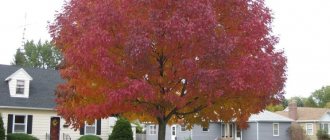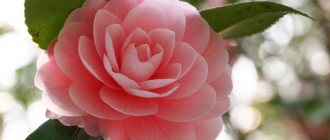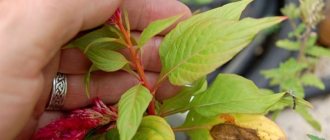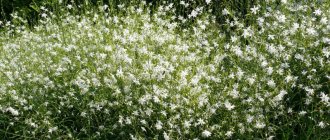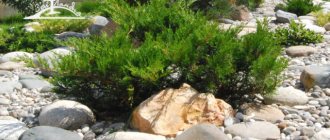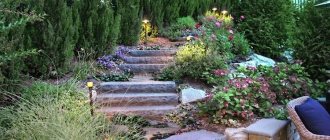Aphelandra (Aphelandra) - tall herbaceous shrub - a frequent luxurious “guest” of home greenhouses, originally from the American tropics.
Under home breeding conditions, the height of a representative of the Acanthus family reaches 30-70 cm. It is characterized by rapid growth of leaves and shoots (more than 4 per year). The lifespan of young plants is no more than 2 years.
It is distinguished by large spike-shaped inflorescences and dark green foliage with a waxy tint, topped with white or cream-colored veins.
Domestic flower growers are familiar with the perennial as a long-blooming domestic ornamental crop. The flowering phase occurs at the end of summer or beginning of autumn and lasts more than one month.
| High growth rate. In one year there are 6-7 new leaves. |
| It blooms in summer, but with high humidity it can bloom in winter. |
| Aphelandra blooms in summer. Flowers with yellow inflorescences. |
| Annual plant. Blooms for one year. Next, the plant is cut. |
Briefly about care
| Type of agricultural operation for caring for aphelandra | Description of conditions and actions |
| Watering and air humidity | It is moisture-loving, so you need to water it with warm, settled water at least 2 times a day (the soil should always be moist); needs to be sprayed |
| Lighting organization | Loves sunlight, but should avoid direct sunlight, which can cause leaf burn |
| Maintaining a rest period | It takes place in the winter season: you need to lower the temperature, but not lower than 18 ° C and stop fertilizing; You can prune to stimulate flowering |
| Creating temperature conditions | In the summer, the air temperature should not exceed 25 °C; in winter the thermometer should not fall below 15 °C |
| Trimming | Needed to give a decorative appearance to the shrub. Pruning should be done in spring |
| Making soil mixture | The soil composition should include: turf soil, peat and coarse sand |
| Fertilizer application | The plant needs to be fertilized several times a month. |
| Transfer | Young aphelandra needs to be replanted every year. An adult plant needs to be replanted once every three years. |
| Chemical treatment | Insecticides: scale insects, aphids, mites, mealybugs; fungicides: root rot |
Transfer
Every spring, before flowering, the flower is replanted, otherwise the aphelandra will quickly lose its attractive appearance. The soil should be loose and contain leaf and humus soil, sand, and peat.
During the same period, pruning is carried out; in the end, only a few, but the most developed shoots should remain.
Description of the plant
Aphelandra or aphelandra (Aphelandra) is a perennial, tropical shrub that can reach a height of one meter and one and a half meters. In the wild, the flower can grow up to two meters in height.
Aphelandra
The exotic plant is characterized by dense and thick green leaves with white stripes. The stem is erect, over time it becomes coarser and becomes covered with bark.
Interesting! Aphelandra is associated with many signs and superstitions in the house. A flowering plant promises joy and happiness for household members.
Sometimes gardeners confuse indoor flowers such as alocasia and aphelandra. The similarity of colors is manifested in the snow-white striped pattern on dark green leaves, but these are completely different crops belonging to different families.
Always decorative
Aphelandra is a representative of tropical flora, a moisture-loving and heat-loving flower of the acanthus family. It is grown as an ornamental leafy and ornamental flowering houseplant. This is a perennial subshrub or shrub with large contrastingly colored leaves, in nature reaching a height of two meters. Domestic aphelandras grow no more than 1–1.3 m, and for the most part they are lower, especially if you buy a compact variety.
Aphelandra sap is considered poisonous, so pruning and replanting is carried out with gloves.
The leaf plate of the flower is shiny, can be corrugated and smooth. The color is variegated: on the green surface of the leaf there is an ornament of white or silver stripes along the middle and lateral veins.
Aphelandra flowers are small, but the bracts are very decorative: they are bright and collected in the likeness of a faceted spike or pyramid 10–15 cm long. There are orange, yellow and red colors.
Aphelandra bracts are more decorative than flowers
The flower's homeland is considered to be South American and North American tropical rainforests.
It is considered to be a very finicky plant and requires a lot of effort to grow successfully. This is not entirely true: if you initially provide the aphelandra with optimal conditions for it, it will grow and delight you with its flowering.
What you should know before buying aphelandra
| Mature plant size | Up to 1.5 meters in height, and leaf length 0.7 meters |
| Lifespan | Perennial plant, but requires renewal every 2 years |
| Bloom | Blooms from June to September; inflorescences are bright, orange, raspberry, scarlet, lemon in color |
| Aroma | Without smell |
| Safety | All parts of the plant are poisonous |
| Difficulty of care | Difficult for beginners |
| Uniqueness | Rare view |
| Where can I buy |
Bloom
Depending on the variety and conditions, aphelandra can bloom from two months to six months. Pick off wilted inflorescences immediately.
And in order for the bush to bloom magnificently next year, it should organize a period of rest. Keep the flowerpot in the autumn-winter period in a bright, cool place. Water occasionally, and there is no need to feed at all.
Home care
Aphelandra requires careful care at home, as it is a rather capricious plant. However, if you make an effort and properly care for the exotic shrub, it will reward your household with long-lasting and delightful flowering.
Watering
Aphelandra is a moisture-loving plant, so you must ensure that the soil does not dry out. Watering is needed as needed. The soil should always be slightly moist. In hot weather, you need to water the flower as often as possible, sometimes even several times a day. Watering the aphelandra should be plentiful, but moisture stagnation should not be allowed, otherwise this may cause root rot of the plant.
Watering aphelandra
Important! Water for irrigation should be settled, filtered and warm. When watering, you need to make sure that water does not get on the wide leaves.
Illumination
After purchasing an exotic flower, it is important to think about where to place it in the house. It is advisable to place the pot with the plant in the eastern or western part of the windows. In the northern part, the flower will lack natural light.
Important! In the absence of light, the flower will stretch upward, lose its shape and may die.
It is important to ensure, especially in summer, that the burning rays of the sun do not fall on the bush.
Humidity
The shrub likes to be in humid air, since the plant’s usual habitat is the tropics. Being in dry air, aphelandra's leaves may dry out. In winter, you need to provide the tropical flower with warmth and moist air, so you should not keep a pot of aphelandra near heating devices.
Attention! You can provide the plant with moist air by periodically spraying the leaves of the bush. The water should be warm.
Temperature
After purchase, Aphelandra needs to create suitable growing conditions in the house. The temperature regime must be appropriate. In cold winter, it is important to ensure that the thermometer does not fall below 15°C. At other times of the year, the temperature should not exceed 25°C.
It is important to avoid drafts and temperature changes, otherwise this may have a bad effect on the plant.
In the warm season, a pot of aphelandra can be taken out to a loggia or veranda, having previously protected the plant from wind and cold.
Rest period
The resting period of Aphelandra begins in mid-autumn and lasts until the end of winter.
At this time, the plant is provided with a temperature regime of +13o - +15o (only for aphelandra protuberans, for other varieties it remains at least +20o!) while maintaining daylight hours for at least 10 hours. Watering is reduced, but the earthen ball should not be allowed to dry out. Water the plant when the top of the soil dries out. Spraying is also reduced as much as possible.
At the end of winter, the temperature is gradually increased to +22° - +24°, watering and spraying are increased, and fertilizing begins. At the beginning of spring, the plant is pruned and a bush is formed.
The plant quickly forms a lush bush with dense greenery. To give a beautiful shape, pruning . Pinch the tops of the plant to provoke the growth of side shoots - this is done throughout the entire growing season.
Often during a season, aphelandra grows so much that the lower part of the branches sheds the lower old leaves, the trunk becomes bare and the plant does not look very attractive. To prevent this, at the end of winter, before the period of active growth, all old branches are cut off, leaving small (about 20 cm) stumps with dormant buds, from which new shoots will grow in the spring. After pruning, it is recommended to spray the plant and put a plastic bag on top for better and faster recovery.
Cut tops can be easily rooted and planted in the same pot to add extra density.
Replanting is required once a year for young plants. Adult plants are replanted less frequently - once every 3-4 years.
Reproduction of Aphelandra
It is possible to reproduce aphelandra at home. You can propagate the shrub by cuttings or by planting seeds.
Seeds
Aphelandra seeds
You can plant the seeds in the spring. To do this, you need to prepare a suitable container with soil. Leaf soil mixed with sand is suitable for seeds. After planting, you need to moisten the soil and create a mini-greenhouse for the seedlings to sprout. The crops need to be ventilated daily. After fresh shoots appear, you can plant them in separate pots.
Cuttings
Aphelandra cuttings
It is also possible to propagate Aphelandra by cuttings at home. The cutting method is quite simple and even a novice gardener can handle it. It should be propagated by cuttings in the spring. It is necessary to cut several healthy cuttings from an adult plant.
The cut sites should be treated with an antifungal agent. Then the cuttings are placed in sandy soil and covered with film. Once a day it is necessary to ventilate the seedlings. After the shoots produce roots, they can be planted in separate containers.
How to propagate
There are several ways to propagate a flower. But this is in theory, but in practice everyone chooses what is simpler. Since aphelandra is short-lived, it is useful to know how to propagate it.
It is possible to plant a flower with seeds. They are sown in March-February. But cuttings are the most convenient. Young shoots with at least 2 leaf blades and a growth point are suitable. They are cut for propagation in the spring. Proceed as follows:
- Using a knife, cut off the shoot below the 2nd pair of leaves. The selected area of the plant should not show signs of any diseases.
- Before pruning, prepare a small pot and soil. Use a mixture of wet peat and perlite or coarse sand.
- The stem just below the leaf is also cut off. If there is more than 1 pair of leaves on the shoot, only the top ones are left, cutting off the rest.
- The cutting must be placed in water or dipped in a hormonal agent to stimulate root formation. For example, heteroauxin. Excess powder is shaken off.
- A hole is made in the soil. Insert a cutting into it so that its tip reaches the bottom of the hole and the leaves do not touch the ground.
The plant is watered abundantly. A frame is made above the pot - an arc of wire. Cover it with polyethylene to create damp conditions. The film is removed every day for 5 minutes, and the flower is watered if necessary. The temperature under the dome should be +24°C. After 3 weeks, the film is removed.
This is interesting: in Japan, the plant is used in folk medicine to treat burns; it is also believed that contemplation helps relieve neurological pain.
Diseases and pests
The plant is quite capricious and can get sick if suitable growing conditions are not observed. The most common disease of shrubs is root rot. It manifests itself in the fact that the leaves of Aphelandra turn yellow and turn black. Root rot appears due to frequent and abundant watering.
Stagnant water causes the root system to begin to rot. The disease can be eliminated by adjusting the watering regime. If the roots are damaged, it is necessary to remove the plant from the ground, wash the roots, and cut off the rotten ones. Sprinkle the cut areas with crushed activated carbon to prevent subsequent rotting.
With drafts and temperature changes, shrub leaves may be shed. It is necessary to protect the flower from hypothermia or overheating.
Mealybug on aphelandra leaves
Common pests that can settle on the plant are scale insects, aphids, and mealybugs. Insects are dangerous because they feed on the sap of the aphelandra and also secrete a sticky secretion that can cause disease in the flower. To avoid a disastrous neighborhood, you should regularly inspect the plant and wipe the leaf blades. If insects are found on a flower, you should give the bush a soapy shower. In advanced cases, you will have to resort to the use of insecticides.
Temperature
As we have already mentioned, domestic aphelandra is quite capricious and requires some care. First of all, take care of the absence of drafts and compliance with temperature parameters.
For example, in winter, fifteen degrees of heat is enough, in the demi-season period - about twenty. During the summer months, keep the flower at about 24 degrees Celsius.
Varieties and varieties
There are more than 150 varieties of aphelandra in nature. Each type of tropical flower has its own characteristics of care and external differences. Let's look at the two most popular varieties of flowers.
Protruding
Aphelandra squarrosa is characterized by its low stature and fleshy, glossy green leaves with white striped patterns. The Aphelandra squarrosa flower begins to bloom in June. Flowering is long-lasting, lasting until mid-late autumn. Aphelandra flaunts with bright, spike-shaped bracts. Orange petals attract with their brightness.
This variety has several hybrid varieties: “Leopolda”, “Louise”, “Denmark”.
Denmark
Aphelandra “Denmark” (A. Dania) is a popular variety. This variety is characterized by dark green leaves covered with white stripes and lemon-colored inflorescences resembling cones.
Aphelandra Denmark
Bleached
Also among the hybrid varieties one can distinguish a “bleached” crop. Aphelandra White Wash has wide leaves with a snow-white pattern.
Aphelandra bleached
Golden
Golden or orange aphelandra (A. aurantiaca) reaches 30-50 cm in height. The country of origin of this variety is Mexico. The stem is erect, covered with bark. The leaves are wide and silver-green in color. The inflorescences are large and orange in color. Flowering does not last long - only a week.
Golden Aphelandra (Aphelandra aurantiaca)
Retzl
A popular variety is Aphelandra aurantiaca var. Roezlii. This variety is characterized by silvery leaves and delightful scarlet inflorescences. In apartment conditions, Retzl's aphelandra does not bloom for long - about a week. This variety is propagated only by cuttings.
Folk signs
Aphelandra is most suitable for people born under the constellation Leo. Because red, yellow and orange exotic flowers perfectly match their temperament.
But other zodiac signs may well start growing such beauty. After all, according to Feng Shui, upright plants stretching vertically upward bring positive energy into the house.
Medicinal properties
People suffering from neurological diseases should definitely pay attention to the “simple man”. Aphelandra leaves can help:
- under stress;
- increase performance;
- relieve fatigue.
For those who suffer from neuralgia, a flower pot will help alleviate the painful condition.

